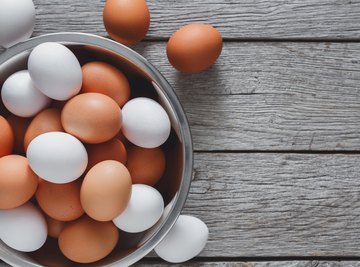
The “egg in bottle” science project is a popular and entertaining way to demonstrate basic scientific principles learned in class. This experiment shows how differences in pressure create a vacuum-- with mind-boggling results. There are a few different ways to perform the experiment and illustrate some key concepts.
TL;DR (Too Long; Didn't Read)
Dropping a lit match into a bottle lowers the air pressure inside the bottle. This creates a vacuum and allows a hard boiled egg to fall through the small opening into the interior of the bottle.
Basic Egg in Bottle Experiment
The egg in bottle experiment requires a hard-boiled egg with its shell already removed. You should choose an egg that is slightly too large for the opening of the bottle (or choose a bottle that has an opening slightly too small for your egg). Use your fingers to smear some water around the opening of the bottle. Light a match and drop it into the bottle. Immediately place the egg over the opening, ensuring the opening of the bottle is completely covered. Watch as the egg begins to wiggle around the opening. When the match goes out, the egg should drop into the bottle.
Removing the Egg
For quick removal, use a straw, fork or other long object to break up the egg and dump out the pieces. For a more scientific removal of the egg from the bottle, there is an alternative technique for removing the egg intact. Turn the bottle upside-down so that the egg rests against the bottle neck. Put your mouth to the opening and blow as hard as you can. This increases the pressure inside the bottle so that the egg can escape. Move your face away from the bottle quickly and catch the egg as it pops out.
Variations on the Experiment
You can also perform this experiment with a balloon instead of an egg. For this variation, fill a balloon with water until it is slightly larger than the opening of the bottle you’re using. Use your fingers to wet the opening of the bottle and repeat the basic experiment with the balloon instead of the egg.
Another variation involves repeating the egg experiment with the bottle upside down. Insert two birthday candles into the narrower end of the egg, light the candles and hold the bottle a few inches above the egg. Hold the bottle there for a few seconds to allow the candles to heat up the air inside the bottle then lower the bottle so the edges touch the egg. Watch the candles go out and the bottle suck the egg into its interior.
Key Concepts
The key concepts demonstrated by the egg in bottle project involve vacuums and pressure. The egg held against the bottle opening prevents outside, higher pressure air from entering the bottle while the lit match inside the bottle causes the lower pressure air inside the bottle to contract. The difference in pressure creates a small vacuum, which allows the egg to fall through the opening into the bottle.
